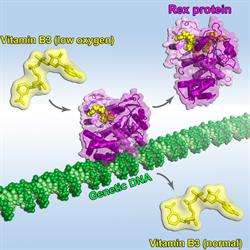Vitamin B3 Controls Important Life Processes by Changing Shape in Response to Oxygen Level

(PhysOrg.com) -- Scientists have obtained the first images of a common molecular signal, vitamin B3, which plays a role in making some bacteria potent and some men impotent.
For the first time, researchers have captured three-dimensional images of a protein in the act of responding to oxygen levels by sensing vitamin B3. Vitamin B3, also known as niacin, is essential to convert the food we eat into energy. Since vitamin B3 carries electrons from metabolized food to oxygen, it serves as a sensitive indicator of oxygen levels in cells. Vitamin B3 also regulates a variety of processes, including erectile dysfunction, aging and sleep patterns in people. The findings, published in the journal Molecular Cell, could guide future development of antibiotics, and in the long term, new treatments for erectile dysfunction.
The research team at the University of Rochester Medical Center used specialized instruments to show how the bacterial protein ‘Rex’ tracks the oxidation state of vitamin B3, which gains electrons when oxygen levels are low. Under normal oxygen conditions, Rex binds both vitamin B3 and the genetic material DNA; there, Rex blocks gene activity. When the oxygen levels decrease, Rex remains bound to the electron-rich state of vitamin B3, but undergoes a massive change in shape. The shape change releases Rex from the DNA, thereby freeing genetic information to cope with the limited oxygen supply. This transformation is central to how proteins use vitamin B3 to sense oxygen levels and alter metabolic pathways accordingly.
Rex proteins are prevalent among pathogenic bacteria that cause anthrax infections, toxic shock syndrome, and pneumonia. Understanding how these proteins influence cell signaling offers scientists a new way to try to stop the microbes that cause such infections. In humans, an analogous vitamin B3 sensing system is involved in producing nitric oxide neurotransmitters essential for the erectile process.
“Vitamin B3 has been the focus of intense interest since its role as a signaling molecule was discovered, yet no one knew how proteins, the molecular machines of the cell, could sense the slight differences between the oxidized and reduced forms,” said Clara Kielkopf, Ph.D., associate professor in theDepartment of Biochemistry and Biophysics at the University of Rochester Medical Center and lead study author. “An exciting implication of our findings is that antibiotics could be developed to change the shape of Rex-like proteins and turn off genes needed for a bacterial infection.”
The work has implications for research beyond toxic pathogens and impotence. Many organisms are responding to changing oxygen levels constantly, and understanding how they do so is crucial. In people, for instance, a lack of oxygen leads to arrested cell division and ultimately cell death, while excess oxygen levels can damage cellular building blocks and contribute to a variety of diseases including cancer, diabetes, cardiovascular disease and neurodegenerative disorders.
“It’s amazing to think that less than 10 years ago no one knew the Rex pathway existed, and now we have obtained detailed structural snapshots of the Rex protein in action that allow us to understand how cells can respond to low oxygen levels,” said Krystle McLaughlin, a doctoral student responsible for determining the Rex structures in this study. “This knowledge lays the foundation for new ways to manipulate harmful bacterial pathogens and also facilitates our understanding of similar pathways in the human body.”
In the next phase of the research, the team will analyze differences between Rex and other vitamin B3 sensing proteins. Although very similar to the Rex protein investigated here, subtle differences in the Rex proteins that cause anthrax and other pathogens are likely to be important for drug development. Research will also focus on several human proteins that sense vitamin B3 signals. Detailed three-dimensional shapes of these molecules responding to the oxidized versus reduced forms are needed both to understand human aging and metabolism and to guide the design of specific antibiotics.
“This is an elegant example of how modern structural biology can reveal molecules that assume alternate shapes, and how those shapes control important life functions and response to infection,” said Robert Bambara, Ph.D., chair of the Department of Biochemistry and Biophysics at the Medical Center.
More information: Journal paper: www.cell.com/molecular-cell/abstract/S1097-2765%2810%2900368-0
Provided by University of Rochester Medical Center













